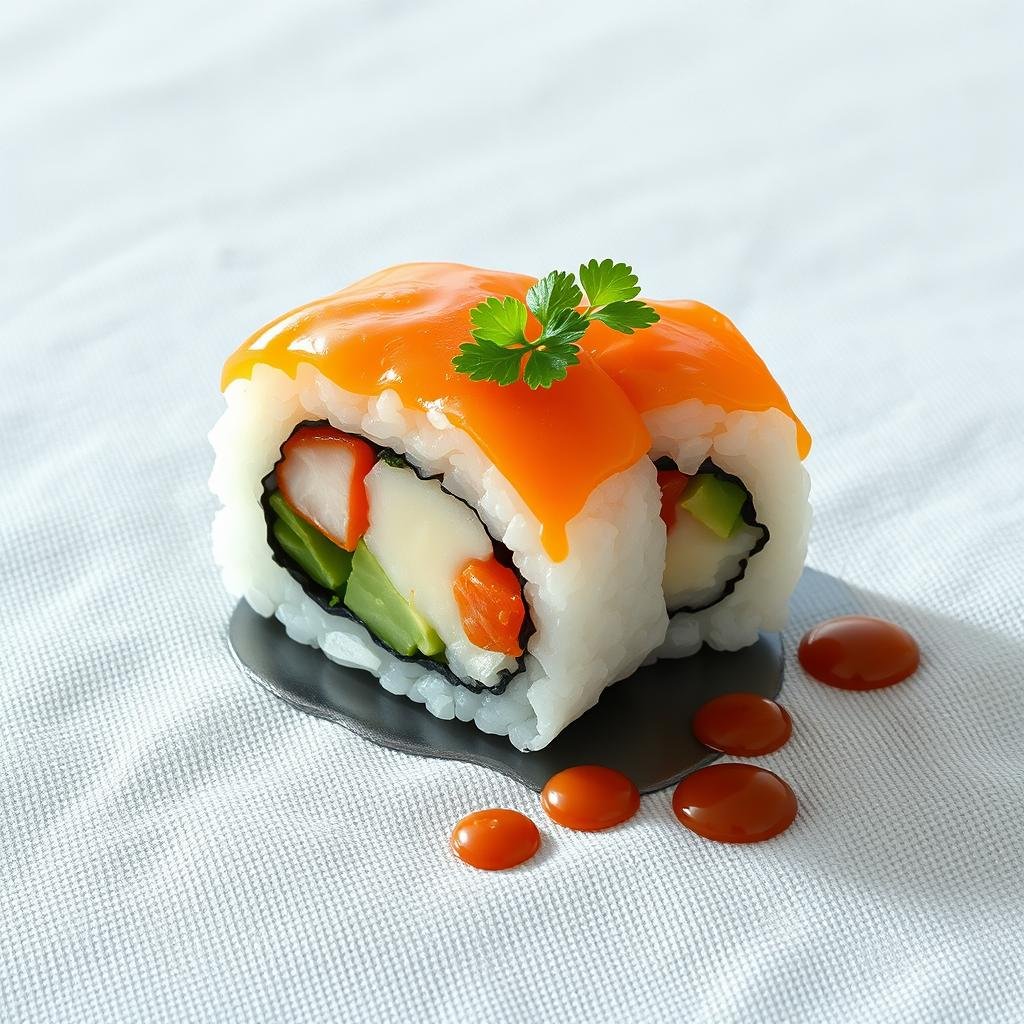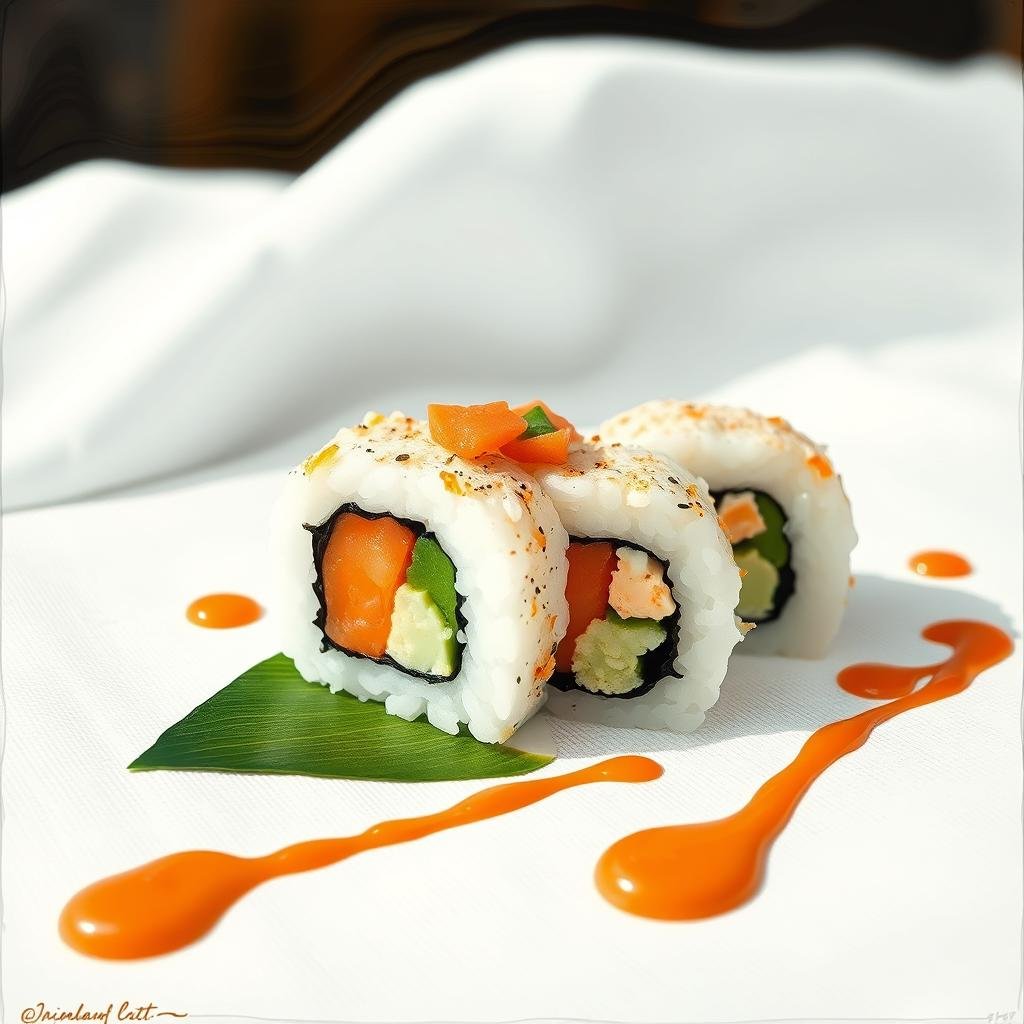Haiku Sushi Roll
Haiku Sushi Roll — crafted carefully for the menu of the Poet’s Café
Choosing a Dish (Haiku Sushi Roll)
On the linen breeze,
a menu hums in whispers—
pick with your own heart.
✨ Why this works
- Form: 5-7-5 syllables (classic haiku rhythm).
- Mood: Evokes nature (“linen breeze”), a living menu (“hums in whispers”), personal choice (“pick with your own heart”).
- Subtle teaching: Readers experience haiku spirit — small moment, deep feeling — without being told it’s a lesson.
🧠 Reflection
By placing this tiny poem under the Haiku Sushi Rolls on our menu, we make guests feel haiku, not just “order” it. 🍃✨
It stays light, fresh, and precise — just like a sushi roll and a haiku should.

On the linen breeze,
Mlaure
a menu hums in whispers—
pick with your own heart.
What is a Haiku
Origins of Haiku
Haiku is a traditional form of Japanese poetry that has its roots in the earlier collaborative linked-verse poetry called renku. The earliest haiku evolved from the hokku, which was the opening stanza of a renku. The term haiku itself became popularized in the late 19th century by the Japanese poet Masaoka Shiki, who advocated for the form as a standalone genre.
Style of Haiku
Haiku poetry is characterized by its simplicity, brevity, and focus on nature or seasonal themes. Traditionally, a haiku consists of three lines with a syllable structure of 5-7-5, totaling 17 syllables. Key elements of haiku include:
- Kigo (Seasonal Word): A word or phrase that indicates the season, connecting the poem to nature.
- Kireji (Cutting Word): A word that provides a pause or break, often adding emotional depth or contrast.
- Imagery: Haikus typically rely on vivid imagery to evoke feelings or reflections rather than expressing direct emotions.
Notable Haiku Poets
Matsuo Bashō (1644-1694): Perhaps the most famous haiku poet, Bashō is known for his profound and evocative nature poems. He traveled extensively, and his works often reflect his experiences and observations of the natural world.
Yosa Buson (1716-1784): A painter and poet, Buson combined visual artistry with poetry. His haikus often depict serene natural scenes and contain rich sensory details.
Kobayashi Issa (1763-1828): Known for his humorous and compassionate perspective, Issa’s haikus often highlight the lives of common people and the beauty of everyday moments.
Masaoka Shiki (1867-1902): A modernizer of haiku, Shiki is credited with establishing haiku as a distinct poetic form and is also known for incorporating a more personal voice into the genre.
Kawabata Yasunari (1899-1972): Nobel Prize-winning author and poet who incorporated haiku into his literary works, contributing to the form’s global recognition.
Conclusion
Haiku remains a popular form of poetry not only in Japan but worldwide. Its emphasis on simplicity and nature allows poets to express profound thoughts and emotions in just a few syllables, making it a unique and enduring art form.
What is a Sushi
Sushi is a traditional Japanese dish that typically consists of vinegared rice combined with various ingredients such as seafood, vegetables, and sometimes tropical fruits. Sushi can be presented in a variety of forms, including rolls (makizushi), hand rolls (temaki), and nigiri, where a slice of fish is placed atop a mound of rice.
How Sushi is Made
Prepare Sushi Rice: Sushi rice is short-grain rice mixed with rice vinegar, sugar, and salt. The rice is rinsed to remove excess starch, cooked, and then cooled with a fan or by hand while being mixed with the vinegar mixture.
Prepare Fillings and Toppings: Fresh ingredients like raw fish (e.g., tuna, salmon), cooked seafood (e.g., shrimp, crab), and vegetables (e.g., cucumber, avocado) are prepared. The fish should be high-quality and safe for raw consumption.
Rolling Sushi: For maki sushi, a bamboo mat is often used:
- Place a sheet of nori (seaweed) on the mat.
- Spread a thin layer of sushi rice over the nori, leaving a small edge at the top.
- Add your fillings in a line across the center.
- Roll it tightly using the mat, applying gentle pressure to form a cylinder.
Cutting: The rolled sushi is sliced into bite-sized pieces with a sharp knife, often dipped in soy sauce and served with wasabi and pickled ginger.
Nutritional Value
Sushi’s nutritional value varies significantly based on the ingredients used. However, here are some general guidelines:
- Calories: Sushi can range from approximately 200 to 400 calories per serving (6-8 pieces) for rolls, but this may vary based on the fillings and sauces.
- Protein: Sushi made with fish is a good source of protein, which is essential for muscle repair and growth.
- Fat: Fish, especially fatty fish like salmon, are rich in omega-3 fatty acids, which are beneficial for heart health.
- Carbohydrates: The rice provides carbohydrates for energy, but it’s important to watch portion sizes if you’re monitoring carb intake.
- Vitamins and Minerals: Sushi often contains ingredients rich in vitamins and minerals, such as seaweed (iodine, calcium) and vegetables (fiber, vitamins).
Famous Sushi Chefs
Jiro Ono: Often regarded as one of the greatest sushi chefs in the world, Jiro Ono is the owner of Sukiyabashi Jiro, a renowned sushi restaurant in Tokyo that has received multiple Michelin stars.
Masaharu Morimoto: A well-known chef and television personality, Morimoto gained fame through his appearances on the Iron Chef series and has restaurants worldwide.
Nobu Matsuhisa: The chef behind Nobu restaurants, Matsuhisa is famous for his fusion of traditional Japanese cuisine with Peruvian ingredients.
Easy Sushi Recipe
Simple Cucumber Roll (Kappa Maki)
Ingredients
- 1 cup sushi rice
- 1 1/4 cups water
- 2 tablespoons rice vinegar
- 1 tablespoon sugar
- 1/2 teaspoon salt
- 1 sheet nori (seaweed)
- 1 small cucumber, julienned
- Soy sauce (for serving)
- Wasabi and pickled ginger (optional)
Instructions
Prepare the Sushi Rice:
- Rinse the rice under cold water until the water runs clear.
- Combine the rinsed rice and water in a rice cooker or saucepan. Cook according to the rice cooker instructions or bring to a boil, then reduce heat and cover, simmering for 18-20 minutes until water is absorbed.
- In a small bowl, mix rice vinegar, sugar, and salt until dissolved. Once the rice is cooked, transfer it to a bowl and gently mix in the vinegar mixture. Let it cool to room temperature.
Assemble the Sushi:
- Place a sheet of nori on a bamboo mat or clean surface, shiny side down.
- Wet your hands and grab a handful of sushi rice. Spread it evenly over the nori, leaving about 1 inch at the top.
- Place a line of julienned cucumber in the center of the rice.
- Using the mat, carefully roll the sushi away from you, pressing gently to keep it tight. Seal the edge of the nori with a little water.
Cut and Serve:
- Use a sharp knife to slice the roll into bite-sized pieces.
- Serve with soy sauce, wasabi, and pickled ginger if desired.
This simple cucumber roll is a great starting point for anyone wanting to try making sushi at home! Enjoy your sushi-making adventure!

Ever made a Haiku? Or Sushi rolls?
Let us know in comments…

















